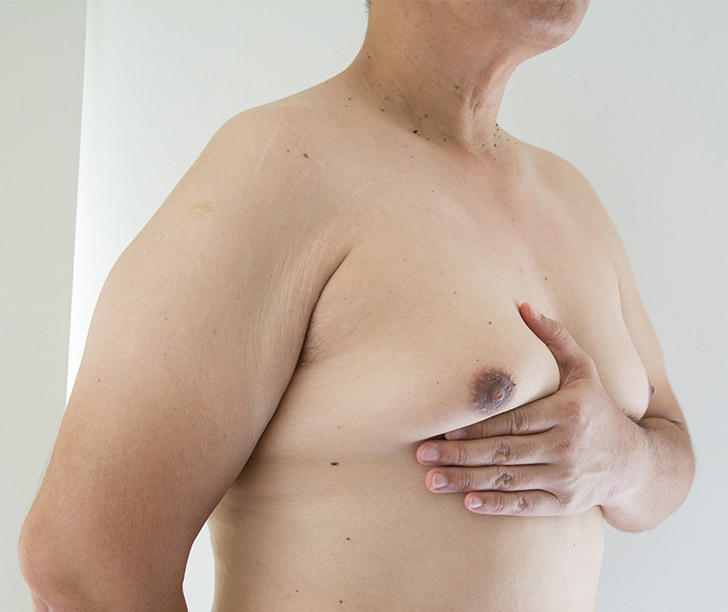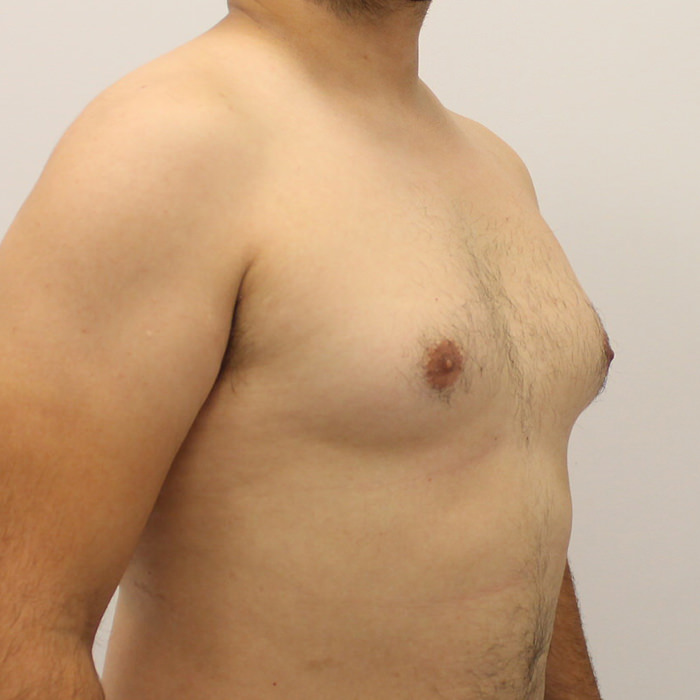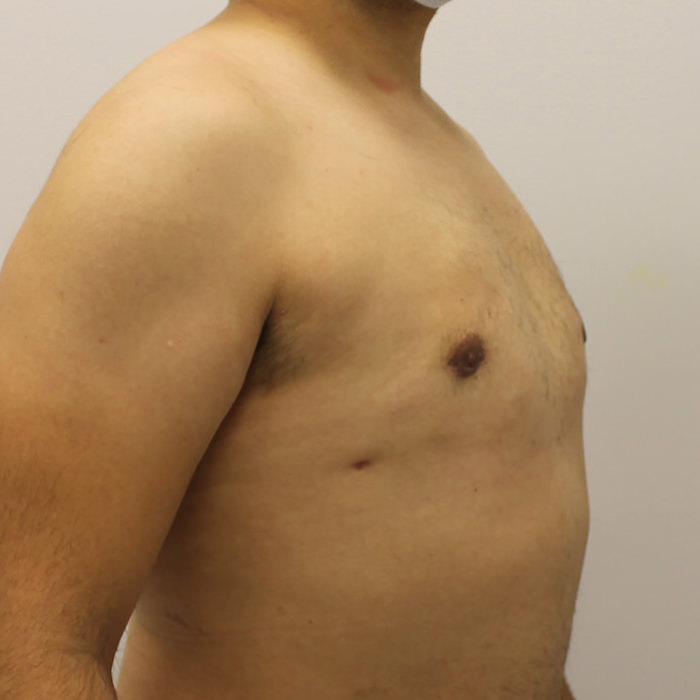Gynecomastia is a condition where the breast tissue in men enlarges on one or both sides of the chest. It can be transient (such as in puberty) or permanent. In cases where it does not resolve, it can be due to obesity, medications (such as steroids), hormonal imbalances, or genetics. Some basic medical tests, such as a blood test and ultrasound, will be done to evaluate the cause and ensure the breast tissue is normal. A gynecomastia will define and sculpt a flatter chest, elevating confidence and creating a more masculine appearance.
Patients who are good candidates for this procedure
- Healthy weight
- Not taking steroids
- No significant medical problems
- Non-smokers
- Not on blood thinners

Patients who are poor candidates for this procedure
- Obesity
- Smoking
- Significant medical problems
- Taking blood thinners
- Significant weight loss
Are you a good candidate?
Our Self-Evaluation Quiz can help you decide if gynecomastia correction is the right procedure for you.
Techniques for gynecomastia
Gynecomastia involves liposuction to remove fat and sculpt the chest for a flatter, more defined appearance. Dr. Gdalevitch will also make a small incision at the bottom of the areola to surgically remove the excess breast gland. Incisions for this procedure are hidden and inconspicuous. Once healed, they generally become unnoticeable.






Discover the procedure through live surgeries
Gynecomastia presentation
Consent for gynecomastia
Pre op instructions for gynecomastia
At Phi Plastic Surgery, we believe that a beautiful body can take many shapes and sizes. The Phi philosophy centers on respecting your body's proportions and helping you let your inner beauty shine.
We offer our patients the best, most advanced techniques to help them achieve their aesthetic goals.
Pre-op & post-op instructions
These pre-surgical and post-surgical instructions are provided as essential services for you. Please follow the instructions carefully to ensure optimum results. If there are instructions that need to be clarified, please feel free to contact our office as soon as possible. If some instructions are not followed, your surgery could be delayed if deemed necessary by your surgeon.
Pre-op INSTRUCTIONS
THREE WEEKS before your surgery
- Stop all consumption of collagen.
- Complete your pre-operative tests. Be sure to complete all prescribed pre-operative tests (ECG blood tests, etc.). If your tests’ medical results and clearances are received on time, your surgery may be completed on time.
- Prepare your surgery date: Plan to ensure a stress-free experience. Arrange your work leave and special assistance to help you with a ride home. Prepare your return by organizing meals, delivery, babysitting, etc. Make sure you have someone scheduled to accompany you home after your surgery. Someone should also be on-call to help you during the first 24 hours after your surgery.
TWO WEEKS before your surgery
- Stop the consumption of anti-inflammatory drugs.
- Aspirin, drugs containing aspirin or any anticoagulants such as Arixtra pf, clopidogrel, Plavix, coumadin, dalteparin, edoxaban, eliquis, apixaban, enoxaparin, Fragmin pfsyringe, lepirudin, Pradaxa, dabigatran etexilate, Xarelto, rivaroxaban.
- A pre-operative visit (if necessary) approximately two weeks before your surgery will be scheduled to review your goals and provide you with additional information regarding your surgery.
SEVEN DAYS before your surgery
- Stop taking any supplements or medications from the list below. These products can increase the risk of bleeding and other complications. Stop consuming any non-prescribed supplements, including: Omega 3-6, nutricap, echinacea, glucosamine, fat burners, St. John’s wort.
- Confirm your surgical support plan: This includes your transportation and post-surgical care, including an adult family member or a friend on-call for your support 24 hours after your surgery.
- Purchase any prescription provided by Dr. Gdalevitch (If applicable) and revise your pre-surgical instructions.
The day BEFORE your surgery
Prepare a bag. It should include the following:
- All necessary papers
- Your identification (RAMQ card)
- Prescription Drugs
- Glasses if necessary
- Confirm who will assist you for the first 24 hours after surgery.
- Take a shower. Use a non-perfumed soap. Wash your hair. Do not put cream or lotions. Do not put deodorants, hair products, perfumes, or makeup on.
- Remove any nail varnish (even if transparent) from your hands and feet, including shellac, resin, gel or acrylic. All this reduces the risk of post-surgical infections, and nails are monitored for blood circulation.
- Do not eat or drink dark liquids for 8 hours before your surgery. Do not drink any light liquids 6 hours before your surgery. Anything you eat can cause the cancellation of your surgery and increase the risks associated with surgery and anesthesia. This includes sweets, mints, chewing gum, tea or coffee. You can take a minimal amount of water after brushing your teeth or taking medication.
- Relax. Enjoy a good night’s sleep and avoid stress.
YOUR SURGERY DAY
- If you wish to have oral sedation, do not eat or drink 4 hours before the surgery. Present yourself at the time confirmed to you by a staff member one week before.
- Do not train before surgery.
- Please bring your medications which have been prescribed to you in a bag as above.
- Please bring your compression socks if they have been prescribed to you.
- Do not wear any makeup, jewellery, contact lenses, hairpin or piercings: during surgery, an electric cautery is used, and any piercing or jewellery can cause burns.
- Wear light and comfortable clothing. Wear a top that opens forward. Do not wear a sweater, turtleneck or tight clothing. You can wear a skirt, but pants and a jogging jacket are ideal. Flat shoes that are easy to put on and remove (no heels) should be worn. A lip balm is recommended.
post-op instructions
When you get home
You can expect to have some pain in the breasts. You may feel like it is challenging to take a deep breath.
To help you rest comfortably, follow these instructions:
- Take extra-strength Tylenol every 4 hours
- Take an anti-nausea medication such as Gravol 30 minutes before taking your prescribed pain medication
- Take your pain medication as prescribed
- Take your antibiotics as prescribed
- Try and rest in a semi-sitting position until bedtime
- Avoid using your arms for anything strenuous
- Keep your surgical garment in place
- Apply ice to your upper breast area (10 minutes on, 10 minutes off)
Contact us immediately if you experience any of the following:
- Pain that is not controlled by the pain medication
- One breast is unusually large, painful and bruised.
- A fever of greater than 38.5
- Severe nausea or vomiting
- Hallucinations or incoherent behaviour
- Pain or swelling of one calf
- Excessive bleeding through your dressing
The first day following surgery
- Your pain will start to dissipate after 48 hours.
- Avoid staying in bed all day, and rest in a semi-sitting position.
- Avoid strenuous activities with your arms.
Healing and follow up
- Your breasts will not be fully healed for 4-8 weeks.
- Exercise is not permitted until four weeks after surgery.
- You should rest for at least one week after surgery and gradually regain daily activities, except for strenuous upper body activities or exercise.
You will have a follow-up appointment 1-2 weeks after surgery, then at one month and three months.
Your results
Recovery from a gynecomastia consists of taking pain medication for the first 48 hours. Patients can go home on the day of surgery, and recovery is usually 2-3 weeks. A compression garment on the chest is worn for 4-6 weeks after surgery.
A gynecomastia will help you obtain a flat chest and will accomplish the following:
- Removal of excess breast tissue
- A reduction in breast size for a more masculine and defined look
- Improved appearance in clothing
- Increase self-confidence and self-esteem
The result is a permanent, more sculpted chest.


View most frequently asked questions
What kind of scars will I have?
Gynecomastia results in minimal scarring, with most scars hidden in the pigment of your skin around the areola.
What kind of anesthesia will be used?
Depending on the patient’s preferences, this procedure can be done as an awake or asleep procedure.
How long does the surgery take?
Gynecomastia takes approximately 1 ½ – 2 hours. Plan on being at Phi Plastic Surgery for around 3 hours on the day of your surgery. Since you will be coming out of anesthesia, you will need someone to drive you home from the center and stay with you for 24 hours after the surgery.
What happens at my initial consultation?
During your consultation with Dr. Gdalevitch, she will discuss your goals and which approach would be most beneficial to you. You’ll also discuss what you can expect concerning recovery, complications, and scars.
Are there complications with gynecomastia surgery?
The most common complication is an accumulation of blood in the wound. This is not a severe complication, and many times, the blood can be drained with a needle. Occasionally, we have to open the wound to drain the blood.
How much does the procedure cost?
Gynecomastia
starting at $9,000

For a more beautiful and proportional you!
φ Phi is the Greek symbol that indicates the golden ratio, a ratio that is synonymous with beauty.
Dr. Perry Gdalevitch offers a unique approach that involves applying the principles of perfect proportions (phi) to help you achieve your aesthetic and reconstructive goals.

 PLASTIC
PLASTIC